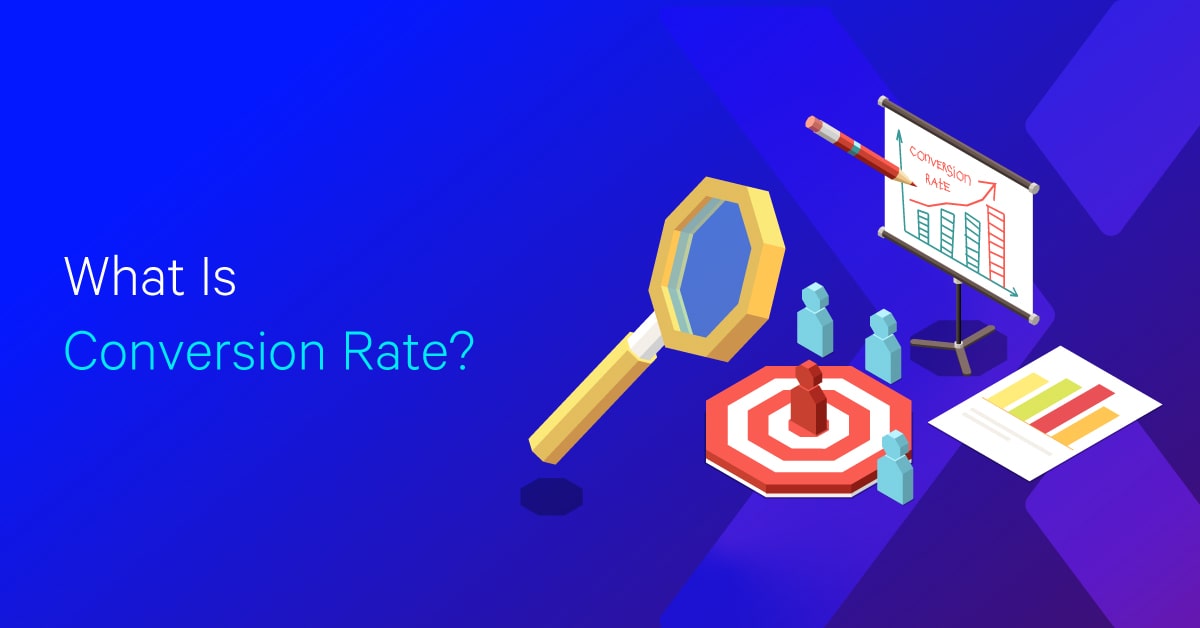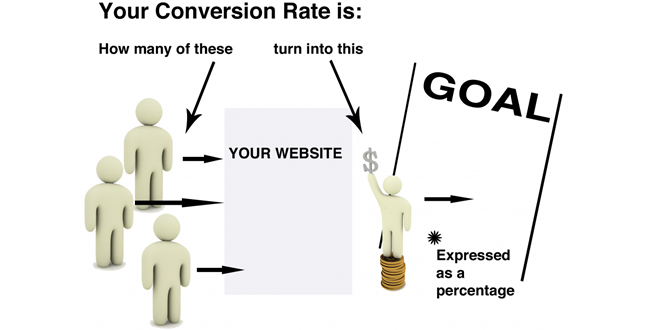What Is Conversion Rate?

Hand off the toughest tasks in SEO, PPC, and content without compromising quality
Explore ServicesLess than a quarter of businesses are happy with their conversion rates.
Should you have the same reaction? Well, that depends.
The more you consider your conversion rate and what constitutes a good conversion rate, the more you begin to ask, “Is my conversion rate that important?” Both yes and no.
You may examine your conversion rate from a variety of angles, just like every other online marketing metric.
This is due to the fact that Conversion Rate Optimization (CRO) may often result in an abundance of unqualified leads.
While this is not always the case, the situation of boosting your conversion rate at the expense of lead quality highlights the necessity of including lead quality in your CRO plan. You should aim to boost the conversion rate of qualified leads over all leads.
So, what’s conversion rate exactly?
This article will help you understand what conversion rate means, its importance, how to calculate conversion rate, and how conversion rate affects SEO.
Let’s get right into it!
What Is Conversion Rate?
A conversion rate is the percentage of users that execute a specific action. Conversion rates are computed by taking the total number of visitors who ‘convert’ (for example, by clicking on an advert), dividing that amount by the total size of the audience, and turning that value into a percentage.
Simply defined, your conversion rate is the proportion of visitors to your website or landing page that convert (aka, do what you want them to do). A “convert” might be nearly anything depending on your company goals, however here are a few frequent types of conversion goals:
- Buying anything
- Signing up for a paid or free membership (such as a newsletter)
- Signing up for the site
- Filling out a form (contact us form, lead gen form, etc)
- Clicking a CTA button
- Contacting your company
- Participating in your online conversation
- Obtaining something (software trial, eBook, mobile app, case study, etc)
- Using anything (new/advanced feature on your software or app, using your software/app for a set period of time)
- Participating in some manner with your website (time on site, repeat visits, number of pages visited)
Assume an advertiser starts a mobile ad campaign on Facebook with a target audience of 10,000 individuals. A total of 400 individuals have clicked on the ad out of those 10,000 persons (which is the conversion event in this scenario). As a result, the overall conversion rate for this campaign is as follows:
400/10000 = 0.04, or a conversion rate of 4%.
With the information that 4% of people who viewed an ad converted, marketers now have a statistic to attempt to improve for future growth.

Why Is Conversion Rate Important?
Conversion rates are a powerful tool for evaluating and contrasting the effectiveness of various advertising platforms. As in the previous example, conversion rates are very essential when executing mobile user acquisition campaigns since they allow you to track the performance of each marketing campaign. When scaling a campaign, they may also be utilized to define ROI expectations.
Conversion rate analysis, when performed appropriately, may indicate which channels are most effective for marketing a certain app, allowing an advertiser to assess the efficacy of their text and utilize it to drive and refine marketing strategy decisions.
If your data reveals that your average conversion rate is lower than planned, you may use it to identify difficulties with an app’s UX (User Experience) and suggest other areas for improvement. For example, when website visitors are having trouble logging in.
According to research, the average mobile conversion rate is about 1.53 percent.
Although there is no one conversion rate that can be used to define success in the mobile advertising business, research into industry standards and vertical-specific conversion expectations might be beneficial. This study may be used to compare these numbers to the performance of your in-house advertising efforts across a variety of social media channels.
Conversion rates do not always refer to clicks; they can also refer to conversion events that occur further down the sales funnel. For example, the percentage of site visitors who went on to install an app or complete an in-app action can be calculated. This is useful for both advertisers and marketers because it allows them to identify potential customers. This data can then be reintroduced into the funnel.
In contrast to other methods of measurement, such as click-through rate or cost-per-click, the conversion rate immediately informs you about how effective your marketing initiatives are.
Conversion Rate FAQ
Does conversion rate affect SEO?
When focused on increasing website performance, you cannot neglect conversion rate optimization (CRO) and search engine optimization (SEO). The former is a technique for boosting the number of page visitors that are subsequently “converted” into new customers by taking the desired action such as subscribing to a newsletter, purchasing an item, writing a review or testimonial, etc.
Exactly how you count conversions differs depending on what type of site you have and what kind of services you aim to give. The latter is the process of boosting the number of visitors that arrive on your site by way of search engine results. This guarantees that more visitors are drawn to your site.
And, the more individuals who discover your web page, the more likely you are to have a boost in conversions as well.
CRO and SEO are inextricably linked. Working on one can lead to advancements in the other. However, it is not only strong SEO that may contribute to higher conversion rates. In reality, the majority of the procedures in conversion rate optimization result in enhanced SEO numbers.
After all, SEO is more than just utilizing the appropriate keywords to increase the visibility of your website. When it comes to displaying search results, there are numerous elements that contribute to Google’s search engine algorithm, and focusing on your conversion rates can have a direct influence on how that algorithm ranks your site.
What is a good conversion rate?
The issue with conversion rates is that even a 0.5 percent increase may be significant.
Furthermore, we must emphasize that the best brands achieve greater outcomes.
A good conversion rate is between 2% and 5%.
A respectable conversion rate is greater than 10%, with some firms attaining an average of 11.45%. Earning a decent conversion rate positions your firm in the top 10% of worldwide marketers, putting your conversion rate two to five times higher than the average.
So what constitutes a decent conversion rate for an eCommerce site?
Ecommerce conversion rates are quite poor, especially when compared to finance. However, an eCommerce business with a conversion rate of 3.71 percent may make more money than a legal services firm with a conversion rate of 6.46 percent.
This is due to the fact that legal is a specialty that does not attract a large number of buyers. Ecommerce, on the other hand, may attract a greater number of users.
This demonstrates how conversion rates for eCommerce may differ. A business that sells gifts may have a greater conversion rate than a store that sells sports equipment.
Device and Conversion Rates
We know that a large number of users browse the web using mobile devices, so it’s important to understand how the rate varies from device to device.
Here’s a quick rundown of conversion rates of devices:
- 1.82 percent for mobile
- 3.49 percent for tablets
- 3.90 percent on the desktop
You may be surprised to learn that mobile users do not convert as well as desktop users. As a result, mobile website conversion rates may be slightly lower than average website conversion rates.
How do you calculate conversion rate?
Conversion is actually rather simple to calculate. Simply divide the number of conversions in a specific time period by the total number of individuals that visited your site, homepage, product page, or landing page and multiply by 100 percent.
Conversion rate = (number of conversions / total visits) * 100%
For example, if your site received 17,492 visitors and 2,305 conversions in the previous month, your conversion rate is 13.18 percent.
Isn’t it simple? In reality, if you set up your conversion tracking correctly, most online advertising (e.g., Google Adwords, Facebook Ads), analytics, and testing tools (e.g., Google Analytics) can display your conversion rate directly in their interface.
One of the wonderful things about conversion rate is that you can be as specific or as wide as you want with it. Here are a few different sorts of conversion rates to consider, as well as methods for analyzing performance based on this data:
- Overall conversion rate (How effective is your website at converting traffic from any source?)
- Page-level conversion rate (which of these pages converts more traffic into paying customers?)
Campaign conversion rate (did my targeting adjustments make a difference?) - Marketing channel conversion rate (does Google Ads traffic convert better than Facebook Ads traffic?)
- Individual ad conversion rate (does my ad wording need to be changed? Does this advertisement generate more qualified traffic?)
- Keyword conversion rate (which keywords should receive more funding?)
Obviously, this is only a partial list.
Here are three conversion rate formulae to consider:
- Conversion Rate = total number of conversions divided by the total number of sessions multiplied by 100
- Conversion Rate = total number of conversions divided by the total number of unique visits multiplied by 100
- Conversion Rate = total number of conversions divided by the total number of leads multiplied by 100
Please keep in mind that all three of these formulae are correct. The ideal approach to compute conversion rate is dependent on what you define as your conversion event and how you want to measure traffic. The numerator will be your conversions (as determined by your conversion rate target), while the denominator will be your whole pool of traffic (generally session count, unique visitors, or leads).
Ready to Give Your Conversion Rate a Boost?
Hopefully, this article has given you a better understanding of conversion rate.
A good conversion rate is fantastic, but could you go even higher?
Loganix is here to help you find out. With our SEO services, our expert digital marketing team can create and run CRO experiments and A/B tests that will assist your business in increasing its conversion rate.
Concentrate on experiments and modifications that will attract your ideal lead or customer rather than anybody else in your market. Examine your findings and consider how they influenced the experience of qualified leads vs everyone who visited your site and took part in the trial.
When you pay attention to this detail, you may improve the accuracy and value of your conversion rate.
If you work with an SEO service agency like Loganix, you can be confident that our team will focus on increasing the conversion rate of your most important audience members since that is what will grow your business.
Hand off the toughest tasks in SEO, PPC, and content without compromising quality
Explore ServicesWritten by Aaron Haynes on October 3, 2021
CEO and partner at Loganix, I believe in taking what you do best and sharing it with the world in the most transparent and powerful way possible. If I am not running the business, I am neck deep in client SEO.





